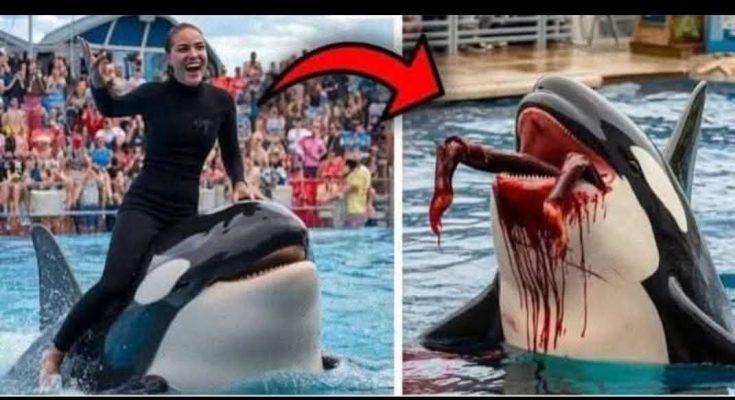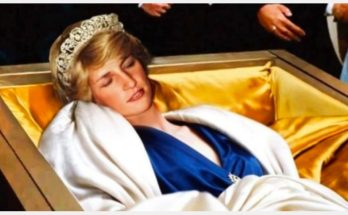Orca Trainer is 😱 Devoured by THIS One While Performing – The Chilling Truth Behind the Tank 1. The Day Everything Changed (Scene by Scene)
The Florida sun blazed over SeaWorld Orlando as crowds packed into the stadium. Laughter echoed. Phones clicked. Trainers rehearsed their polished movements beside a shimmering blue tank.
Among them: Dawn Brancheau, a beloved, veteran trainer. Known for her radiant smile, she was a fan favorite.
Today was just another show. The orca performing with her: Tilikum — SeaWorld’s largest orca, a breathtaking 12,000-pound giant.
As music swelled through the speakers, Dawn interacted with Tilikum for the finale: a dramatic pool-side rubdown. She leaned toward him, smiling, as the crowd cheered.
But then — in the blink of an eye — everything changed.
Witnesses described the scene with horror:
“The whale grabbed her so fast, it was like lightning.”
Tilikum lunged, grabbing Dawn by her ponytail and yanking her into the water with terrifying strength. Screams erupted. Staff rushed to the scene. Sirens blared.
But it was too late.
Tilikum dove deep, thrashing violently. He wasn’t letting go.
2. Who Was Dawn Brancheau?
Dawn wasn’t a rookie. She had 15 years of experience working with orcas. She knew the risks better than anyone.
In interviews, friends recalled her saying:
“You can never turn your back on a killer whale.”
But Dawn had also formed deep bonds with the animals. She trained meticulously. She followed every protocol.
Yet Tilikum — whose massive size made him a liability — was supposed to be treated differently. Trainers weren’t even allowed to swim with him due to his history.
So why was she so close?
SeaWorld officials later called it a tragic “accident.” But some insiders whispered: It was only a matter of time.
3. The Hidden Past of Tilikum
Tilikum’s story didn’t start in Florida.
Born in the icy waters off Iceland, he was captured at just two years old. Separated from his pod, he was confined in a tiny holding tank, barely big enough to turn around.
Later, at Sealand of the Pacific in Canada, his life grew darker.
Confined with two dominant females who regularly raked him with their teeth, Tilikum lived a life of bullying and isolation.
In 1991, tragedy struck: 21-year-old trainer Keltie Byrne fell into the tank.
Tilikum — along with the other whales — dragged her underwater. She drowned before she could be rescued.
Despite this, Tilikum was sold to SeaWorld.
Why?
Because of his immense size — and his value for breeding.
4. Captivity Changes Everything
In the wild, orcas swim up to 100 miles a day.
They live in complex family units, often staying with their mothers for life. They hunt, play, and socialize.
In tanks, orcas swim in circles.
They float listlessly at the surface.
They develop collapsed dorsal fins (seen in over 80% of captive orcas, but only 1% of wild ones).
They suffer.
Marine mammal experts like Dr. Naomi Rose argue:
“Captivity damages these animals physically and psychologically.”
And the danger?It doesn’t just threaten the whales — it threatens the humans around them.
5. Blackfish: The Documentary That Changed Everything
In 2013, a shocking documentary rocked the world: Blackfish.
Using interviews with former trainers, secret documents, and graphic footage, Blackfish told the full story of Tilikum — and the dark side of marine parks.
The film argued that SeaWorld:
Downplayed the risks to trainers
Hid Tilikum’s history from the public
Continued breeding orcas despite repeated attacks
Key moments from Blackfish:
Former trainers breaking down in tears recalling how orcas were separated from their calves
Footage of violent orca incidents kept hidden from the public
Stunning aerial shots of wild orcas — juxtaposed with tiny tanks
Blackfish sparked outrage. Celebrities like Matt Damon, Ellen DeGeneres, and even Willie Nelson condemned orca shows.
SeaWorld’s stock plummeted.
Attendance dropped.
Lawsuits flew.
Change was coming — but was it enough?
6. What REALLY Happened That Day?
SeaWorld’s initial statement after Dawn’s death called it “an accident” — suggesting she had slipped or that Tilikum had grabbed her ponytail playfully.
But eyewitnesses — and later, autopsy reports — painted a darker picture:
Dawn suffered multiple fractures (jawbone, ribs, vertebrae)
She drowned — but blunt force trauma contributed heavily
Tilikum repeatedly refused to release her body
Internal emails later revealed SeaWorld knew Tilikum was dangerous.
They knew he shouldn’t be exposed to close human contact.
But the show must go on.
7. The Ethics of Keeping Orcas in Captivity
Should orcas ever be kept in captivity?
That question exploded into the mainstream after Dawn’s death.
Arguments for captivity:
Education for the public
Conservation funding
Close-up research opportunities
Arguments against:
Severe mental and physical health impacts on whales
Misleading portrayals of orca behavior
Risks to human trainers
Countries around the world began banning orca breeding:
Canada passed the Ending the Captivity of Whales and Dolphins Act.
In France, orca shows were phased out.
In the U.S., SeaWorld pledged to end orca breeding.
But for whales like Tilikum, already trapped in captivity, freedom never came.
8. What Happened to Tilikum?
After Dawn’s death, Tilikum was kept mostly isolated.
He performed less and less. He floated listlessly in the water, sometimes motionless for hours.
In 2017, Tilikum died of bacterial pneumonia at SeaWorld Orlando.
He was approximately 36 years old — old by captive standards, but younger than many wild orcas, who often live 50+ years.
Tilikum left behind more than 21 offspring — many of whom still live in captivity today.
His death was mourned by activists — but also raised a bitter question:
Was Tilikum ever truly at fault?
Or was it humanity that failed him?
9. Inside the World of Orca Trainers
Training killer whales isn’t just about tricks and treats.
It requires split-second reflexes.
Unshakable trust.
And constant risk.
Former trainers described the tension:
“You smile. You wave. But in the back of your mind, you know: if this animal wants to kill you… it can.”
Some trainers suffered serious injuries long before Dawn’s death — crushed ribs, broken arms, near-drownings — but were told to smile and continue.
Inside SeaWorld, there was a culture of silence.
“If you spoke out, you were gone,” one trainer recalled.
10. The Legacy of Dawn and Tilikum
Today, SeaWorld has ended orca breeding.
They promise no more theatrical orca shows — instead, focusing on “natural behavior” demonstrations.
But the scars remain.
Dawn’s death — and Tilikum’s long, tragic life — ignited a global conversation about animal rights, corporate responsibility, and the price of entertainment.
Their story became a symbol.
A warning.
And, hopefully, a turning point.
Final Thoughts
When Dawn leaned toward Tilikum that day, she wasn’t reckless. She wasn’t careless. She was doing what she had always done: believing that human love could bridge the gap between wildness and captivity.
But some creatures are too powerful.Too ancient.Too untamed.
Tilikum wasn’t a monster.
He was a prisoner.
And in the end, both he and Dawn paid the ultimate price.
💬 What do you think?
Should orcas ever be kept in captivity again?
Are marine parks evolving — or just rebranding?
Is it possible to truly understand a wild animal’s mind?



